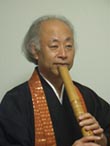Takashi Tokuyama
The shakuhachi came to Japan as an instrument of the Gagaku court orchestra in the Nara period (8th century), and it has remained highly popular up to the present day.Most Japanese people consider the shakuhachi as a part of an ensemble group together with koto and shamisen or as an accompanying instrument to folk songs, and in fact that is how it is mostly being used nowadays. Few people know that there are old pieces for a solo shakuhachi , not involving other instruments or singing.
This traditional solo music is called Honkyoku, meaning real or true pieces, and since it has a long history, we add the word Koten, meaning classic, so it is called Koten Honkyoku. This music is also called Suizen (blowing Zen) and it has been preserved by samurai priests (Komuso) for more than three hundred years.
 In order to preserve and promote this wonderful musical heritage, Mr. Tokuyama has been studying and researching for more than twenty years, including his time as a student at the Tokyo University of the Arts. He has studied with many old masters, travelled and visited many places, consulted old manuscripts, and thus found and recorded many pieces. He has also mastered two main shakuhachi schools, and studied many kinds of music (including Western classical music and jazz, and ethnological music from all over the world). He has been publishing sheet music and text books for Koten Honkyoku, and has made numerous tape recordings. He has visited the United States many times to give lectures and lessons along with his performances. He often writes for Japanese newspapers and magazines.
In order to preserve and promote this wonderful musical heritage, Mr. Tokuyama has been studying and researching for more than twenty years, including his time as a student at the Tokyo University of the Arts. He has studied with many old masters, travelled and visited many places, consulted old manuscripts, and thus found and recorded many pieces. He has also mastered two main shakuhachi schools, and studied many kinds of music (including Western classical music and jazz, and ethnological music from all over the world). He has been publishing sheet music and text books for Koten Honkyoku, and has made numerous tape recordings. He has visited the United States many times to give lectures and lessons along with his performances. He often writes for Japanese newspapers and magazines. Mr. Tokuyama's group also studies Zen, yoga, and Japan's original Shinto religion as part of their training. They welcome all who are interested in Koten Honkyoku.



